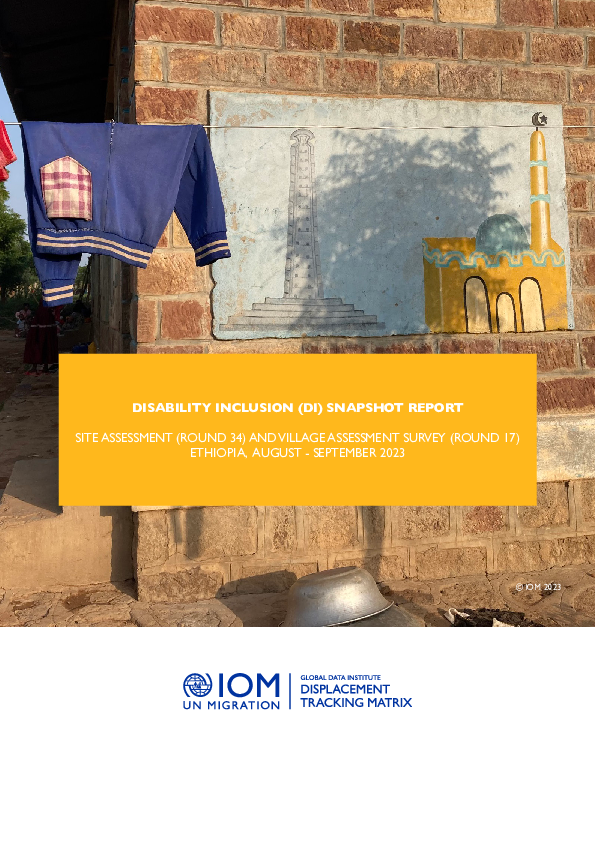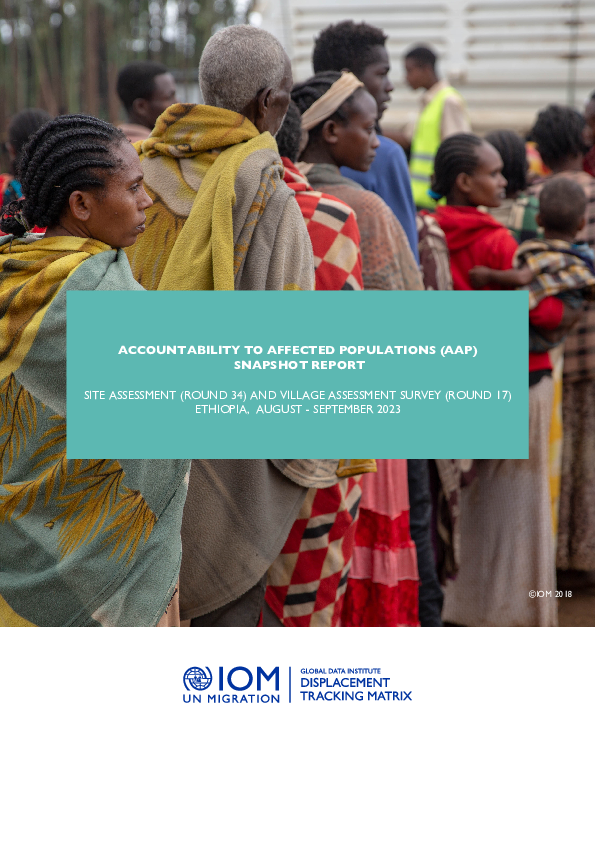-
Countries
-
Data and Analysis
-
Special Focus
-
Crisis Responses
Assessment Report

Contact
DTMAfghanistan@iom.int
Language
English
Location
Afghanistan
Period Covered
Oct 23 2023
Dec 06 2023
Activity
- Survey
- Event Tracking
In early October, four large earthquakes and their aftershocks affected the western province of Herat. Since 23 October, IOM DTM Afghanistan has conducted a household-level assessment to determine the immediate needs and conditions of the affected population. As of 6 December, IOM DTM Afghanistan has covered seven affected districts in Herat, including Gulran, Guzara, Herat, Injil, Karukh, Kushk, and Zindajan. The following key findings report focuses on data collected among:
1) New internally displaced persons (IDPs): people who have been displaced for the first time following the earthquake.
2) Secondary IDPs: people who were already displaced before the earthquake and were displaced again due to the earthquake.
While the following population groups were included in the overall assessment, they are not included in the following report:
1) Returned IDPs: people who were IDPs but have since returned to their location of origin. They are not included in the report due to their small sample size (n=24).
2) Non-IDPs: People who are no longer residing in their original compound but have remained within the limits of their village and thus are familiar with the area and have social connections to support their needs, 20,766 non-IDP households in the affected areas were assessed, however, their information is outside the scope of this report and is therefore also omitted.
The estimated number of IDPs in Herat for 2021 and 2022 was 250,000 individuals according to IOM’s Baseline Mobility Assessment Round 16, making it one of the largest IDP hosting provinces in the country. Data from IOM’s Multi-Sector Rapid Assessment shows that the districts of Zindajan and Injil were most heavily affected by the earthquake, with roughly half of the population in Zindajan and a third of the population in Injil having to leave their homes. The results of this assessment show that out of the affected, roughly five per cent are IDPs (new, secondary, or returned) while 95 per cent had to leave their original homes but remained within the limits of their village.

Contact
dtmlebanon@iom.int
Language
English
Location
Lebanon
Period Covered
Oct 10 2023
Dec 26 2023
Activity
- Mobility Tracking
- Baseline Assessment
Since October 8 there has been an increase in cross-border incidents between Israel and Lebanon, resulting in the displacement of people both within the South and elsewhere within the country. Since October 10, the Displacement Tracking Matrix (DTM) has been conducting the daily monitoring of population movements. The objective of the exercise is to inform preparedness and response planning.

Contact
DTMAfghanistan@iom.int
Language
English
Location
Afghanistan
Period Covered
Dec 08 2023
Dec 08 2023
Activity
- Survey
In early October, Pakistan’s Ministry of Interior announced a decision to enact the “Illegal Foreigners’ Repatriation Plan (IFRP),” setting a deadline for unregistered or undocumented foreigners to voluntarily return to their countries or face deportation. In early December, IOM Afghanistan conducted a household-level phone survey among 4,031 returnee respondents to better understand their priority needs, current conditions including access to services, and migration histories and intentions. Phone numbers for this sample were obtained from the overall returnee caseload that IOM has been supporting at the border with Pakistan.

Contact
DTM DRC, iomdrcdtm@iom.int
Language
English
Location
Democratic Republic of the Congo
Period Covered
Nov 20 2023
Dec 15 2023
Activity
- Event Tracking
Since the beginning of the crisis, IOM, through its Displacement Tracking Matrix (DTM) continues to conduct a series of rapid assessments, including emergency monitoring (EET/ERM), crisis analysis and registration with a priority to respond to immediate information needs with a view to understanding displacement dynamics and needs. This report presents the results of assessments carried out in the various displacement and return areas from 20 November to 15 December 2023.
The displacement data collected in this eleventh crisis analysis shows a further increase in the number of displaced people compared with the previous publication. The total number of IDPs rose from 1,076,261 to 1,240,215 as of 15 December 2023. DTM estimates the total number of newly displaced individuals by the upsurge in conflict at the beginning of December at 163,954. This increase is due to multiple clashes between government and M23 forces, in particular those which have taken place in the territories of Masisi and Nyiragongo, seeing the extension of the M23 group's area of control.

Contact
IOMDTMPoland@iom.int
Language
English
Location
Poland
Period Covered
Sep 01 2023
Nov 30 2023
Activity
- Survey
In March of 2023, IOM Poland launched its Integration Survey to assess the progress and needs relating to labour and social integration of refugees from Ukraine in Poland.
The aim of the assessment is to gain an understanding of the employment situations, housing needs, financial resilience, social cohesion, barriers to accessing services, and short-medium term needs of refugees. In the 1 September - 30 November 2023 period, a total of 1,232 surveys were conducted.
This report provides a snapshot of the social integration of Ukrainian refugees in Poland for the period of September through November of 2023, as well as an overview of key trends based on data collected from March 2023 through November (page 2).
Key Findings
- The length of time spent in Poland is a significant determinant of the level of social integration of respondents. Those who had lived in Poland for more than 12 months at the time of interview had a higher average social integration score* (0.32) compared to those who had lived in Poland for less than 12 months (0. 23).
- The level of social integration reduced consistently as the age of respondents increased, with those 18–24 years old having a much higher average score (0.40), and those over 65 having a lower average score (0.24).
- Students, business owners, and those employed full-time had the highest levels of social integration (>0.39), as compared to those who were retired, unemployed, or carried out family responsibilities, who had the lowest scores (<0.22).

Contact
DTM Ethiopia, DTMEthiopia@iom.int
Language
English
Location
Ethiopia
Period Covered
Aug 01 2023
Sep 02 2023
Activity
- Mobility Tracking
- Site Assessment
- Village Assessment
Between August and September 2023, the International Organization for Migration (IOM), through its Displacement Tracking Matrix (DTM) methodology, deployed the Site Assessment (SA) Round 34 and Village Assessment Survey (VAS) Round 17 assessment tools to assess the mobility, needs and vulnerabilities of Internally Displaced Persons (IDPs) and returning IDPs across Ethiopia.
This snapshot report will present key findings on needs and vulnerabilities, and will focus on obstacles related to accessing shelter/Non-Food Items (ESNFI) and Water, Sanitation and Hygiene (WASH) in the locations assessed through the SA and VAS assessments. The indicators included in the assessments were designed by the Disability Inclusion (DI) expert in country with support from the IOM-DTM team, and aim to shed light on the obstacles that people with difficulties seeing, hearing, walking, communicating and understanding, face in relation to their shelters, accessing distributions and using bathing facilities/latrines. In 61.67% of sites with IDPs, the first obstacle in relation to shelter was physical barriers to enter and leave their home and circulate inside the shelter.

Contact
DTM Ethiopia, DTMEthiopia@iom.int
Language
English
Location
Ethiopia
Period Covered
Aug 01 2023
Sep 02 2023
Activity
- Mobility Tracking
- Site Assessment
- Village Assessment
Between August and September 2023, the International Organization for Migration (IOM), through its Displacement Tracking Matrix (DTM) methodology, deployed the Site Assessment (SA) Round 34 and Village Assessment Survey (VAS) Round 17 assessment tools to assess the mobility, needs and vulnerabilities of Internally Displaced Persons (IDPs) and returning IDPs across Ethiopia.
As part of its commitment to Accountability to Affected Populations (AAP) principles, IOM Ethiopia’s AAP and DTM teams have closely worked together on AAP implementation and mainstreaming in DTM operations. The DTM team reviewed and incorporated indicators related to AAP within the SA and VAS tools, to map communities’ access to feedback mechanisms and involvement in the decision-making process surrounding humanitarian aid. The indicators were included in the August - September 2023 multisectoral assessments which took place nationwide in IDP sites (SA) and villages of return (VAS).
The key findings from the assessments are presented in this snapshot report. Group discussions with IDPs (for SA) and with returning IDPs (for VAS) were asked if members of the target population in the location were aware of mechanisms to provide feedback and make complaints about the quality, quantity and appropriateness of the humanitarian aid they receive. In 59.20% of sites no IDPs in the location were aware of these mechanisms and in 52.56% of villages no returning IDPs were aware.

Contact
DTM Europe, DTMMediterranean@iom.int
Language
English
Location
Latvia
Period Covered
Jul 01 2023
Sep 30 2023
Activity
- Survey
- Return Intention
Key Findings
- Top 3 countries of stay abroad: Poland (34%), Germany (21%), Russian Federation (15%)
- Oblasts of origin: Donetska (27%), Luhanska (21%), Zaporitzka (14%).
- Destinations in Ukraine: going to same oblast of origin (90%), to a different oblast (8%)
- Intentions after arrival to Ukraine: long-term stay (48%), short-term visit (24%), 28% do not know.
- Top needs on the way to Ukraine:* general information (84%), food supply (11%), short-term accommodation (2%).
- Top areas of assistance received:* financial support (92%), accommodation (70%), food (59%)
* more than one answer possible

Contact
DTM Burundi, DTMBurundi@iom.int
Language
English
Location
Burundi
Period Covered
Oct 01 2023
Nov 30 2023
Activity
- Survey
- Return Intention
Depuis 2020, la province de Bujumbura Rural, commune de Mutimbuzi, zone de Gatumba a été récurremment touchée par de fortes inondations affectant plusieurs milliers de personnes. Ces catastrophes naturelles ont engendré des déplacements massifs et la création de sites temporaires d'accueil à Kinyinya II et Sobel (Maramvya) afin de comprendre pleinement l'impact de ces événements et d'élaborer des stratégies de réponse adaptées, l'OIM a lancé une enquête de profilage en octobre 2023. Cette étude méticuleuse a permis de profiler 1 267 ménages déplacés, soit 3 889 personnes, dont certains ont depuis bénéficié d'une assistance pour retourner dans leurs foyers.
L'objectif de cette enquête était double : d'une part, évaluer les besoins immédiats des populations affectées pour orienter l'assistance humanitaire, et d'autre part, recueillir des données pour soutenir la planification à long terme en vue d'une résilience accrue face aux futures crises. Les résultats, qui seront présentés en détail dans ce rapport, révèlent non seulement l'étendue des défis auxquels sont confrontés ces ménages, mais aussi leur résilience et leurs perspectives d'avenir

Contact
dtmlebanon@iom.int
Language
English
Location
Lebanon
Period Covered
Oct 10 2023
Dec 19 2023
Activity
- Mobility Tracking
- Baseline Assessment
Since October 8 there has been an increase in cross-border incidents between Israel and Lebanon, resulting in the displacement of people both within the South and elsewhere within the country. Since October 10, the Displacement Tracking Matrix (DTM) has been conducting the daily monitoring of population movements. The objective of the exercise is to inform preparedness and response planning.
Pagination
- Previous page
- Page 57
- Next page
